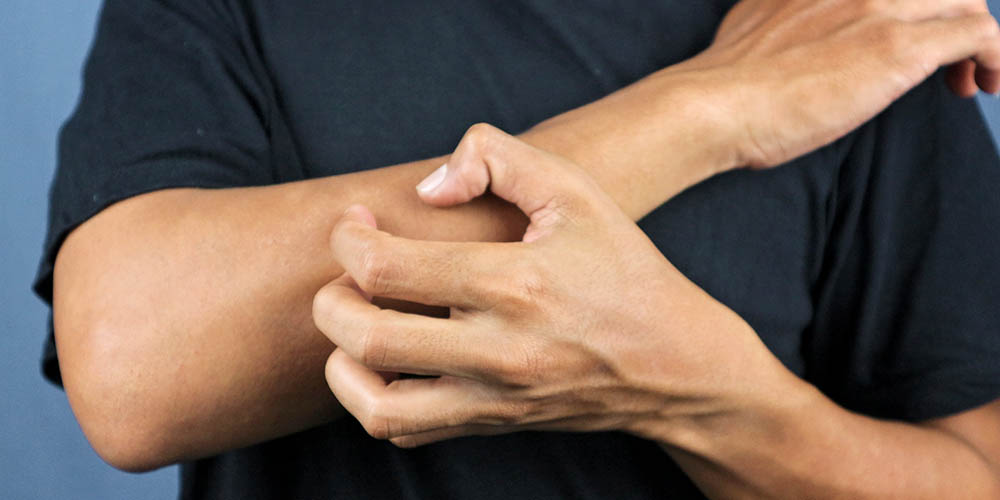
*Important Note: This article contains imagery of skin conditions that may be considered graphic.
*Trigger Warning: Trypophobia
- Several types of skin conditions often affect people with diabetes. The most common are dry skin, fungal infections, and yeast infections. Not as common are acanthosis nigricans, diabetic dermopathy, necrobiosis lipoidica diabeticorum (NLD), and eruptive xanthomas.
- Dry skin is often caused by dehydration, poor circulation, and reduced sweat gland function. Consistently high blood sugar levels can contribute to fungal infections because they provide a favorable environment for fungal growth.
- Though many skin issues associated with diabetes are irritating (literally and figuratively), they generally aren’t a cause for serious concern.
- Preventative measures like moisturizing daily, using mild soaps, wearing breathable clothing, improving glucose control, and practicing good skin and oral hygiene can help to minimize risk and manage symptoms. Good oral health is important in helping to manage yeast production, which can cause oral thrush.
Reading Time: 6 minutes
Even though the skin is the largest organ in the human body, skin issues are often overlooked as a complication of diabetes.
Interestingly, skin problems can be among the earliest visible signs of diabetes. Some skin conditions that people with diabetes are susceptible to can be cause for concern, but most are benign and primarily cosmetic.
The Most Common Skin Conditions that Can Affect People with Diabetes
There are really two main skin conditions that affect people with diabetes the most – dry skin and fungal infections. These conditions can occur in people with both type 1 and type 2 diabetes, as well as people who don’t have diabetes. The good news is that these issues can generally be successfully treated.
Dry Skin (Xerosis)
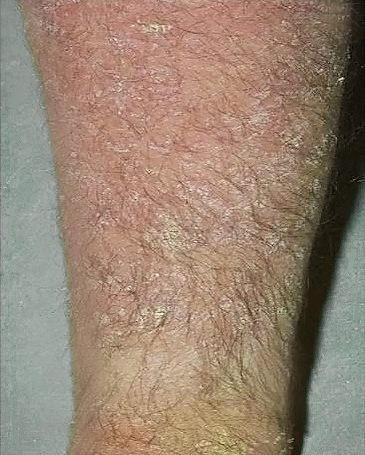
When it comes to skin conditions and diabetes, the most common problem for people with diabetes is dry, itchy skin. It’s primarily caused by dehydration, reduced sweat gland function (especially in people with diabetic neuropathy), and/or poor circulation.
Symptoms Include:
- Itchiness, particularly on the legs, feet, and arms
- Flaky or scaly patches
- Cracking (can lead to infection)
Management Tips:
- Try to improve glucose control, as elevated levels will cause dehydration
- Moisturize daily (apply lotion after bathing when your skin is still damp)
- Don’t put moisturizer between your toes because extra moisture there can cause fungus to grow (moisturizing on and around the toes is fine)
- Use humidifiers in dry climates and during the winter months
- Avoid long, hot baths or showers (but if you do take them, moisturize afterwards)
- Use a mild soap or body wash (like Dove or Cetaphil)
Generally, thicker creams or ointments are preferred over lotions because they provide a better barrier for the skin. Mild, non-scented moisturizers are best.
A few good moisturizer options are:
- Cetaphil
- Curel
- Neutrogena
- CeraVe
- Eucerin
- Vaseline
- Aquaphor
- Vanicream
Exfoliating creams with lactic acid or urea (like AmLactin) are helpful because they unclog and exfoliate pores and cause increased skin turnover. Prescription products can also be used if needed.
Proper skincare routines can go a long way in helping to alleviate symptoms associated with diabetes and itchy skin.
Fungal Infections
Fungal infections are very common in people with diabetes. Other than their physical appearance, they’re generally not cause for concern.
Toenail Fungus
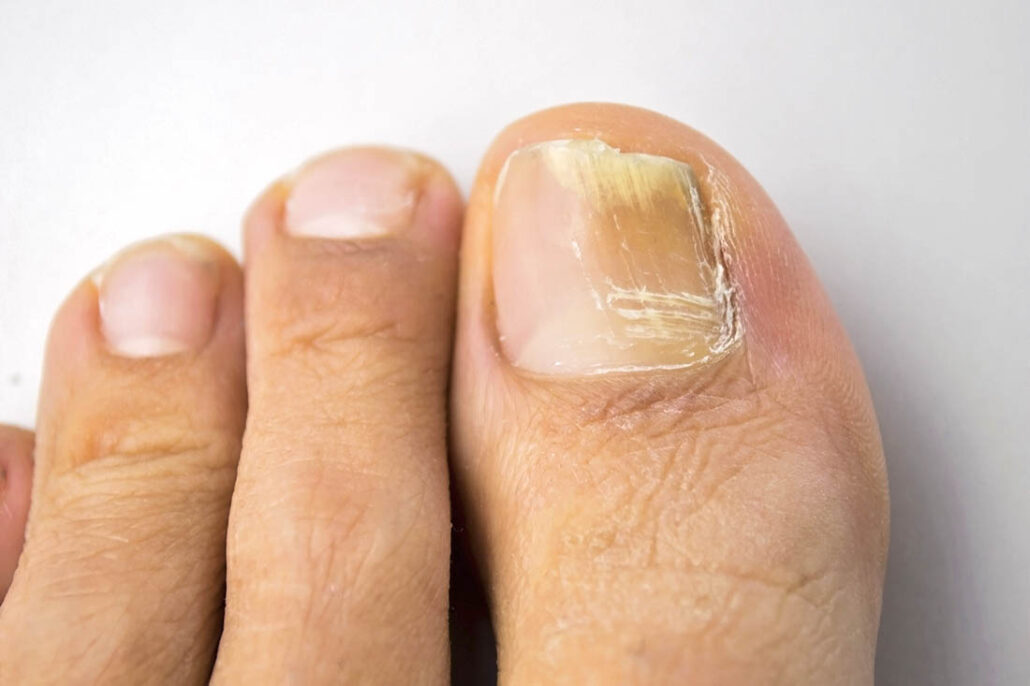
About 1/3 of people with diabetes will have toenail fungus at some point. When nails become infected with fungus, they become thick and yellow and can be hard to cut.
They can also have sharp edges. This is why good foot care for diabetics is so important. Keep your nails clean and short by trimming them or filing them down.
Symptoms Include:
- Thickened nails
- Discolored nails
- Brittle, crumbly, or ragged nails
- Nails that are separated from the nail bed
Management Tips:
Treatment for nail fungus can be challenging. The two main treatment options are oral medications and topical antifungal creams/nail lacquers.
In general, oral medications are very effective and are typically used when fungus appears on the fingernails and is more visible. Treatment will require several months. Commonly, the fungus comes back and will need retreatment.
Oral Medications Include:
- Terbinafine (Lamisil)
- Itraconazole (Sporonox)
- Fluconazole (Diflucan)
Oral meds are up to 80% effective at curing toenail fungus, but they do have side effects. The side effects are generally not severe, but they are important enough to speak to your dermatologist and/or HCP about.
Topical antifungal nail lacquers are often not effective, and there are a lot of online scams for “cures”. Don’t fall for them!
The best advice is to file your nails down and keep them short. Many people see a podiatrist who uses a grinder, which does an excellent job keeping the nails affected by fungus trimmed. If you have neuropathy, please do not do this yourself.
Athlete’s Foot (Tinea Pedis)
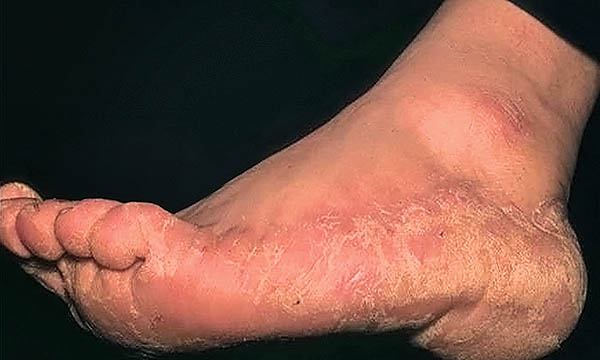
Athlete’s foot, toenail fungus, and jock itch are extremely common and are often caused by the same fungus – they just affect different parts of the body.
Athlete’s foot shows up on the skin of the foot, as opposed to on the nail. It usually starts between the toes, but it can also affect the tops of the feet, the bottoms of the feet, and the heels. It can develop in people whose feet have been sweaty and confined in tight shoes for extended periods of time.
Symptoms of Athlete’s Foot Include:
- Dry, scaly skin on the bottom of the foot that extends up the side
- Scaly, peeling, or cracked skin between the toes
- Itchiness, burning, or stinging
- Inflamed skin that might appear reddish, purplish, or grayish, depending on your skin color
- Blisters
Management Tips:
- Keep your feet dry
- Don’t go barefoot in public places
- Use antifungal powder daily in your shoes
- Wear breathable, moisture-wicking socks
- Avoid tight, non-breathable footwear
Treatment for Athlete’s foot includes over-the-counter antifungal creams, prescription antifungal creams, and oral medications in severe cases. An essential step in foot care for diabetics is to keep an eye out for cracks in the skin on your feet, because they can be portals of entry for infection.
Symptoms of Jock Itch Include:
- A rash that begins in the crease of the groin and spreads down the upper thigh and buttocks
- A rash bordered with small blisters
- Itchy, scaly skin
Management Tips:
- Keep the groin area and inner thighs dry with a clean towel after showering or exercising.
- Change your underwear at least once a day (more if you sweat a lot). Wear underwear made of cotton or another breathable fabric.
Treatment includes over-the-counter and prescription antifungal creams, ointments, sprays, and powders, and prescription oral medications in severe cases.
Yeast Infections

Yeast is a type of fungus. The correlation between diabetes and yeast infections is due to elevated blood sugar levels. People with diabetes can be more likely to get yeast infections (also known as candidiasis) because yeast thrives in a high-sugar environment.
Some medications that treat diabetes such as Farxiga (dapagliflozin), Invokana (canagliflozin), Jardiance (empagliflozin), and Steglatro (ertugliflozin) can also make it easier for yeast infections to occur.
Yeast infections can happen in the mouth (called thrush), on skin fold areas, armpits, genital areas, under the breast, behind the knees, and in finger webs – basically in any area on the body where skin touches skin.
Symptoms Include:
- Mouth: white patches on inner cheeks, roof of mouth, on or under the tongue, redness, soreness, cotton-like feeling in mouth
- Body: skin discoloration, rash with redness and skin breakdown, itching, burning, swelling, little red pustules (small, raised bumps) studding the edge of the affected area
- Genitals: abnormal discharge, itching, burning, redness, irritation, women can also experience pain or discomfort during sex or when urinating
Management Tips:
- Improve glucose control (this tip is always mentioned, but it’s important because poorly controlled diabetes impacts skin health)
- Practice good oral hygiene
- Keep susceptible areas on the body clean and dry
- Choose breathable cotton or natural-fiber underwear and clothing when possible
Treatment can include antifungal creams and powders like Nystatin, Gold Bond powder, Ketoconazole, Spectazole, Lotrimin, and Monistat, and oral medications like Fluconazole.
Other Skin Conditions that Can Affect People with Diabetes
The following skin conditions can affect people with diabetes, though they are not as common.
Acanthosis Nigricans

Acanthosis nigricans is a brown, velvety textural change of skin most commonly found on the underarms, groin, and neck, but the face, elbows, knees, toes, and fingers can also be affected. The changes to the skin can be very subtle or extreme.
This condition is highly associated with type 2 diabetes, obesity, and insulin resistance.
Treating the underlying cause can help make the dark patches fade or even disappear, but unfortunately there are no guaranteed fixes.
Diabetic Dermopathy or “Shin Spots”
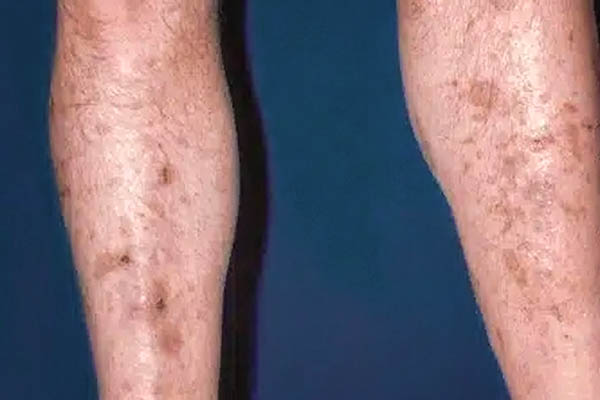
Diabetic dermopathy (or diabetic shin spots) refers to the red-brownish, round, and often indented spots on the shin that occur after minor trauma. Other than being unsightly, diabetic shin spots are not dangerous.
Unfortunately there’s no real treatment for diabetes-related dermopathy, but you can try to improve the appearance of the spots with makeup and/or moisturizers. If you can’t cover them up with makeup, buy some cool pants at Lululemon!
Necrobiosis Lipoidica Diabeticorum (NLD)

NLD, a relatively uncommon condition, is characterized by yellowish to orange patches on the shins or legs. They are firm to the touch and may be shiny and slightly depressed with raised borders. NLD is not usually painful or symptomatic. These areas are very fragile and may bleed and ulcerate under minimal trauma.
High-potency topical steroids such as clobetasol have been used successfully to treat early NLD. Injecting corticosteroid directly into the area is also sometimes helpful. Topical retinoids have also been used.
Eruptive Xanthomas

Xanthomas are cholesterol deposits on the skin caused by uncontrolled glucose and lipids. They are common in people with type 2 diabetes because people with type 2 often have high triglycerides.
Xanthomas often occur suddenly in crops and without warning. Red to yellowish papules can occur anywhere on the body and may be itchy, but often have no symptoms.
Treatment is very effective and consists of reducing triglyceride levels with targeted medications, as well as improving glucose levels.
Frequently Asked Questions
🤔 Why Does Diabetes Affect the Skin?
Chronically high blood sugar levels can damage blood vessels and nerves, reducing circulation and the skin’s ability to heal. This makes it easier for dryness, infections, and irritation to take hold.
Poor circulation also means the skin gets less oxygen and nutrients, which can slow repair and increase the risk of complications, such as diabetic ulcers. In addition, insulin resistance and inflammation can also trigger dermatologic issues.
🧴 How Can I Prevent Skin Problems If I Have Diabetes?
Good diabetes management is the best prevention. Keeping your blood sugar levels in range as much as possible helps reduce the risk of skin issues.
Other tips for managing skin conditions and diabetes include:
- Moisturize daily to prevent dryness
- Check your skin regularly for cuts, sores, diabetic ulcers, or color changes
- Avoid very hot showers and harsh soaps if possible
- During cold, dry months, keep your home more humid with a humidifier
- Do not use feminine hygiene sprays
- Treat wounds promptly and see a healthcare provider for any signs of infection
- Take good care of your feet – check them every day for sores and cuts
Key Takeaways
Diabetes can affect almost every part of the body, including the skin.
Most skin conditions in people with diabetes are treatable, but it’s important to keep an eye out for changes in your skin and talk to your doctor about any concerns you may have.
As Dr. Edelman says, “Your skin is one of your most important organs (yes…for you guys also) and is a reflection of your overall health. It can also be a reflection of serious health conditions such as kidney disease, liver disease, and heart disease.”
Understanding the relationship between skin conditions and diabetes is important for effective treatment. The most common issues – dry skin and fungal infections – can usually be managed effectively with early recognition and proper care.
Key strategies to good skin health include maintaining good blood glucose control, moisturizing daily, practicing good foot and skin hygiene, and promptly addressing any skin changes or signs of infection.
Remember that your skin is the largest organ in your body, so give it the care and attention it deserves!
Visit our video vault and blog for additional resources on how to prevent complications for type 1 and type 2 diabetes, and for other tips on living well with diabetes.


Leave a Reply